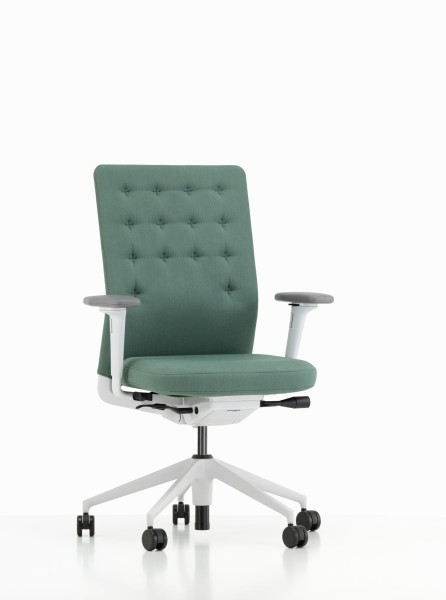With the Flow Motion mechanism, people can live out their natural urge to move in the office if the chair offers movement options. Flow Motion means flowing movement and dynamic sitting. Dynamic or Moving Sitting prevents damage to the spine, venous disorders and mood disorders that can result from a sedentary lifestyle. Muscles are better supplied with oxygen, tension and stress are prevented. The internal organs are better supplied with blood. Individual adjustments allow the chair to adapt to the owner and not vice versa. Technical innovations include not only the forward tilt (FlowMotion) but also the adjustable seat or armrests (2D and 3D).
Vitra ID Chairs in the pro office store
Through different offers, such as the FlowMotion mechanism, the ProMatic mechanism (automatic weight adjustment), seat depth adjustment, different backrests, base frames and armrests, everyone can find his/her individual ID Chair in the pro office store. Aesthetic demands can also be met with the rich selection of covers (soft to rustic leather) and colors to suit every taste and purpose. The ID Air (perforated plastic back), the ID Mesh (upholstered mesh back), the ID Soft (classic upholstery) and the ID Trim (narrow back) or ID Trim L (high back) are available in the pro office Shop. All products conform to Vitra quality, which simulates a 15-year service life. In addition, the ID Chairs carry the "Blue Angel for low-emission upholstered furniture" label and the "GREENGUARD Inder Air Quality Certified Label". The ID office chairs from 2010 are almost completely recyclable and can be reupholstered even after years of use.
The FlowMotion mechanism
The development of FlowMotion was accompanied by ETH in a study to scientifically investigate its benefits. Pressure mats, sensors and questionnaires were used to record human sitting behavior on the office swivel chair. The study proved that pre-leaning movements on the office chair activate the abdominal muscles as well as the "erector spinae". The erector spinae muscle (Latin for "erector of the spine") is also called the back extensor. It is a group of muscles that serve to straighten, stretch, tilt and rotate the spine.
The history of FlowMotion
In the mid-1950s, there were the first scientific observations of the movement processes. Studies brought the first insights into human physics and ergonomics. In 1961, the ETH Zurich (Swiss Federal Institute of Technology) was also concerned with the subject of biomechanics, the mechanism of human movement. At about the same time, the Vitra company in Birsfelden began its own research into ergonomics. The family-owned company also experimented with new materials and technology for the development of office chairs. Fifty years later, the ID Chair Concept was created with the design of Antonio Citterio, an individualized chair system with the FlowMotion mechanism as a new development. The designer Antonio Citterio was born in Italy in 1950 and founded his first own studio already in 1972. In 2000, together with Patricia Viel, he founded an internationally acclaimed studio for architecture and design, "Antonio Citterio Patricia Viel". Translated with www.DeepL.com/Translator (free version)






